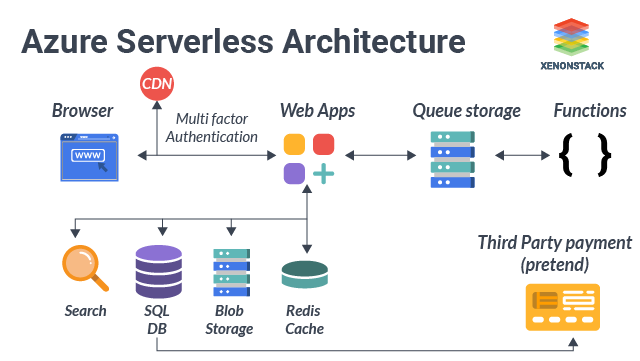Why choose Azure Serverless Computing?
It helps the user build a serverless app, helps the developer focus only on business goals and make an efficient app, and allows them to deploy the app faster in the market.
-
Helps Boost Productivity
Azure Serverless Computing provides Local debugging in Visual Studio, Visual debug history, deployment slot, and many more. A developer can use these to maximise their efficiency.
-
Helps create endless Connections
Azure can accommodate Modern apps of any kind by stitching together many functionalities from various sources.
-
Helps Develop Intelligent Apps Azure has built-in intelligence that allows all developers who want their apps to be innovative. Azure can easily enable the user's code to use machine learning and cognitive services.
Security And Access Control
Azure Active Directory provides developers with the ability to gain access to resources securely and manage their serverless apps.A few more benefits are as follows
-
Cloud Messaging
-
Workflow orchestration
-
API management
-
Analytics
-
Intelligence
Microsoft Azure Serverless Architecture

Fig 1: Microsoft Serverless Architecture
1. Browser (Client)
-
The user initiates a request from the browser.
-
Before accessing the app, Multi-Factor Authentication (MFA) is applied via Azure AD or similar service.
-
The request is passed through a Content Delivery Network (CDN) to improve performance and security.
2. Web Apps (Frontend/Backend)
-
After authentication, the user interacts with Web Apps hosted on Azure App Service (a serverless Paas).
-
These apps handle front-end UI and some backend logic.
3. Backend Services (Data + Cache)
Web apps interact with backend services like:
-
Search: Azure Cognitive Search or similar for fast search capabilities.
-
SQL DB: Azure SQL Database for structured data storage.
-
Blob Storage: Stores unstructured data like images, videos, documents.
-
Redis Cache: Azure Cache for Redis improves performance with in-memory data storage.
4. Queue Storage
-
The web apps place tasks or messages into Azure Queue Storage.
-
This ensures asynchronous processing and decouples frontend from backend logic.
5. Functions
-
Azure Functions (FaaS) are triggered by queue messages.
-
They execute backend logic (e.g., payment processing, data transformation) in a scalable, event-driven manner.
6. Third Party Payment (Pretend)
-
Functions may call external services like third-party payment providers (represented here as “pretend”) to complete transactions or other operations.
What are the Advantages of Azure Serverless Computing?
Below are the advantages of Microsoft Azure:-
Increase developer velocity
Microsoft Azure Serverless helps reduce the time spent on tasks unrelated to the business's core by allowing developers to not think much about infrastructure provisioning and management. It helps deploy the function/application faster with its developer-friendly APIs, ready-to-use machine learning, low-code/no-code services, and cognitive models. -
Boost Team Performance
It helps improve the team's agility and performance by offering a fully managed platform to build, deploy, and operate applications. It also helps manage the applications by providing intelligent services for monitoring and analysis tools provided by Azure. -
Improve Organisational Impact
Azure's solutions help accelerate time to market and clear the path to innovation and new revenue opportunities. It also helps reduce the total cost of infrastructure and ownership and minimise risk through intelligent security management and advanced threat protection.
Developer Tools and Services Provided by Microsoft Azure
Listed below are the tools and services Azure offers.Computation Services
-
Serverless Kubernetes
Azure Serverless helps provide pods elastically in container instances that kick start in seconds without managing additional compute resources. It provides services for orchestration capabilities of AKS (Azure Kubernetes Service) and AKS virtual nodes to create serverless. Both of these are made using the open-source Virtual Kubelet project. It helps with event-driven auto-scaling to users' AKS clusters by adding KEDA. Download the use case AIOps for Monitoring Kubernetes and Serverless.
-
Serverless functions
It helps execute code in any language. The user can scale the deployed application on demand and pay only for the time the code is executed or for the time the services are being used by the application implemented.
-
Serverless Application Environments
Azure App Service helps run and scale any API application on the platform of the user's choice in a fully managed environment.
Workflow and Integration
-
Serverless Workflow Orchestration
It is helpful to integrate data and apps instead of writing complex glue code. Uses Azure Logic Apps to create serverless workflows
-
Serverless API Management
Azure serverless enables Azure API Management to publish, secure, transform, maintain, and monitor APIS.
-
Serverless Messaging
It is used to simplify event-based application scenarios with Azure Event Grid.

Enable DevOps Solutions on Azure using Azure Pipelines and Azure Artefacts. Explore our Azure DevOps Services
DevOps and Developer Tools
-
CI/CD for Serverless
Azure DevOps provides unlimited, cloud-hosted private git repos. It offers many more functions, including adding automatic package management and so on.
-
App Development Tools
It provides tools to build, run, and debug serverless applications using Azure's developer tools.
AI & Machine Learning for Serverless
-
Cognitive Computing
It helps to enable user-serverless apps to see, hear, speak, understand, and interpret users' needs by using Azure Cognitive Services through natural communication methods.
-
Conversation Bots
Azure Bot Service helps build intelligent bots that interact naturally with users through various channels, such as text/SMS, Skype, Microsoft Teams, Slack, Office 365, and Twitter.
-
Machine Learning Models
One can deploy models on Azure Machine Learning from the cloud to the edge.
Database Services
-
Azure Serverless Database
Azure Cosmos DB can be used for the user of the app build for scalable, globally distributed, multi-model database service. Also, Read Serverless Solution for Big Data, and Data Lake
Storage Services
-
Azure Serverless Storage
It can be used for massively scalable storage of unstructured data.
Monitoring Services
-
Azure Serverless Monitoring
As serverless eliminates the traditional infrastructure, debugging Azure provides the right instrumentation. Azure Monitor helps gain observability to the user into their serverless apps.
Analytics Serverless
-
Azure Serverless Analytics
Azure supports running massive parallel real-time analytics on multiple streams of data, including IoT, using Azure Stream Analytics. The Data is processed on demand, and the user pays per job. Building Real-time dashboards is quick with Microsoft Power BI for live command and control views.
Explore here - The Complete Guide to AWS Serverless Computing
AWS Vs Azure Serverless
|
Feature/Aspect |
AWS (Amazon Web Services) |
Azure (Microsoft Azure) |
|
Core Serverless Offering |
AWS Lambda |
Azure Functions |
|
Cold Start Time |
Low (optimized with provisioned concurrency) |
Moderate to low (improved with Premium Plan) |
|
Supported Languages |
Node.js, Python, Java, Go, Ruby, .NET, PowerShell, Custom Runtime |
C#, JavaScript, Python, Java, PowerShell, TypeScript, Custom Handlers |
|
Execution Duration Limit |
15 minutes |
60 minutes (with Premium Plan) |
|
Scaling |
Automatic, nearly unlimited |
Automatic, with better scaling in Premium Plan |
|
Integrated Services |
Deep integration with AWS ecosystem (DynamoDB, S3, SNS, etc.) |
Deep integration with Azure services (Blob Storage, Cosmos DB, etc.) |
|
Trigger Types |
Over 200 sources, including API Gateway, S3, DynamoDB, EventBridge |
HTTP, Event Grid, Service Bus, Cosmos DB, Blob Storage |
|
Monitoring & Debugging |
CloudWatch, X-Ray |
Azure Monitor, App Insights |
|
Pricing Model |
Pay-per-use (invocations, duration, memory) |
Pay-per-use (executions, duration), with Premium Plans |
|
Development Tools |
AWS SAM, Serverless Framework, Cloud9 |
Visual Studio, Azure CLI, VS Code Extensions |
|
Deployment Options |
SAM, CloudFormation, Terraform |
ARM Templates, Bicep, Azure DevOps |
|
Security & IAM |
IAM roles and policies |
Azure RBAC, Managed Identities |
|
Local Testing |
AWS SAM CLI, LocalStack |
Azure Functions Core Tools |
The Road Ahead in Serverless Computing
Microsoft Azure Serverless Computing delivers more value to businesses by reducing the time, money, and resources spent on infrastructure-related needs. By using fully managed Azure serverless solutions, the company gains developers increased productivity, optimal resource use, and faster innovation.
- Quick Read, The Guide to Serverless Security
- Learn About How to Build Serverless Applications on Azure.
.webp?width=1921&height=622&name=usecase-banner%20(1).webp)




